We want to heat your home and help save you money!Our Heating Panels
Due to its efficiency, ongoing heating costs for radiant heat are far less than traditional forced-air systems. They are also quieter and don't reduce air quality. Below you will find a sample of our custom radiant heating control panels. Each panel is designed based on each customer's respective heating requirements, including zones, heating source(s), heating method (in-floor, under-floor, radiant baseboard or radiator) and heat load. We will work closely with you or your contractor to design the best system to fit your needs
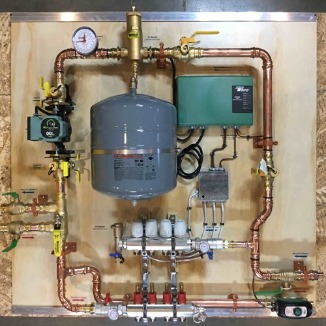
Sometimes it makes more sense to run multiple zones from of a single manifold. This panel incorporates an on-board 4-loop manifold with a zone actuator on each loop (white dome-shaped devices on the top bar of the manifold). This panel sends water to one remote manifold (lower right) and services another three zones via the four loops on the manifold by opening only the corresponding actuators when the zones call for heat. The heat source is a combination propane boiler (heats both floor and domestic water) located to the left of the panel in a primary/secondary configuration. A high efficiency pump compensates automatically for when all or only some of the zones are calling for heat.
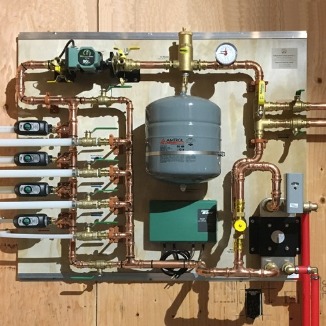
This 4-zone radiant heating panel gets it thermostatically controlled heat primarily from an outdoor wood furnace and a backup propane boiler for times when the furnace runs out of wood. The furnace water runs through the red lines and passes through a plate heat exchanger. The yellow-capped mixing valve tempers the 185°F furnace water down to the proper floor water temperature of 115°F. The backup boiler connects to the two copper lines in the upper right in a primary/secondary loop configuration for efficiency and to ensure the boiler gets a fixed speed of water while the panel gets a varied speed of water based on the demand. The four zone valves pointing to the left connect via Pex lines to the four remote manifolds located throughout the building. The aquastat (small gray box) monitors the outdoor furnace water temperature and disables the backup boiler completely if the furnace water is hot enough to prevent short cycling of the backup boiler.
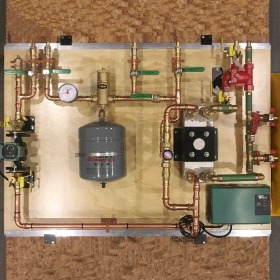
This panel services two zones with a single remote manifold outfitted with actuators connected to the two Pex connectors in the upper left corner of the panel. The primary heat source is an outdoor wood furnace connected to the panel through the green lines and passing through a plate heat exchanger. The two Pex valves pointing to the right go to a side arm heat exchanger for heating the domestic hot water from the outdoor wood furnace. The red, white and blue-capped mixing valve tempers the furnace water down to the proper floor temperature. The remaining two Pex valves pointing up go to a water heater (not the domestic hot water heater) as a backup heat source. Finally, the high efficiency pump compensates automatically for when both or only one of the zones are calling for heat.
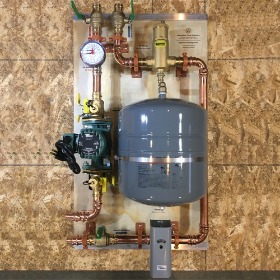
A narrow-width panel designed to replace an outdoor wood furnace by connecting to a wall-hung boiler mounted above the panel and to the existing underground 1†Pex lines running into the building from the furnace that was to be removed. The heating system consists of two series of radiators that rely on mechanical thermostats and require a continuous flow of water through a loop in the crawl space. The pump on the panel runs 24/7 during the heating season and an aquastat (small gray box) on the panel monitors the temperature of the system water and calls for boiler heat as needed.
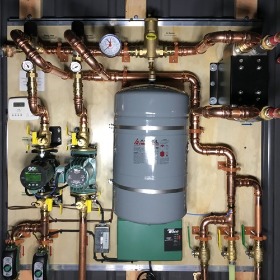
This panel heats a 5,000 SF shop with two zones and a 1,200 SF concrete apron snow melt in front of the shop. The left pump senses the water temperature from the floors and adjusts the flow automatically. The right pump is dedicated to the snow melt due to the increased flow requirement. The sole heat source is an outdoor wood furnace. Each pump has a dedicated mixing valve because the interior and exterior areas require different temperatures of water/antifreeze.
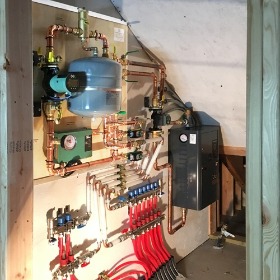
Due to the confined space under a staircase, this system required the electric boiler to be installed to the right and lower than the panel. The boiler connects to the panel with a boiler interface in an efficient primary/secondary loop configuration along with an off-panel pump to provide circulation between the boiler and the panel. Two remote manifolds mounted just below the panel service the two zones of this shome. The pump on the panel monitors the floor water temperature and adjusts its flow automatically for the most efficiency.
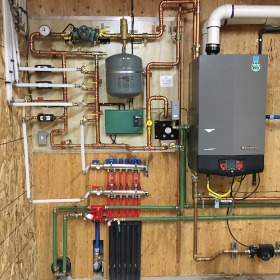
This five-zone radiant panel connects to four remote manifolds (including one just below the panel and one with zone actuators to service two zones). The primary heat source is an outdoor wood furnace with backup heat from a wall-hung boiler. An outdoor snow melt is turned on via a switch in the lower left corner.
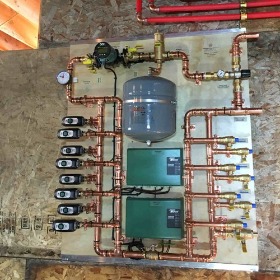
This panel services eight zones in a 5,000 SF basement of a larger 15,000 SF building. An additional panel will be installed for the second and third floors. The primary heat source is an outdoor wood furnace with a 199K Btu backup propane boiler. The heat exchanger for the wood furnace is located off the panel.
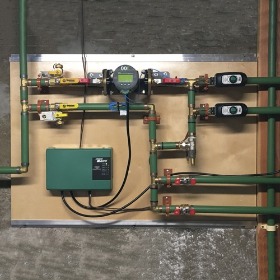
Some panels lend themselves better to Pex piping instead of copper. This panel takes water directly from an outdoor wood furnace and passes it to two zones of baseboard heaters via two zone valves. It uses a pump that senses the incoming and outgoing water temperatures and adjusts the flow automatically.
|